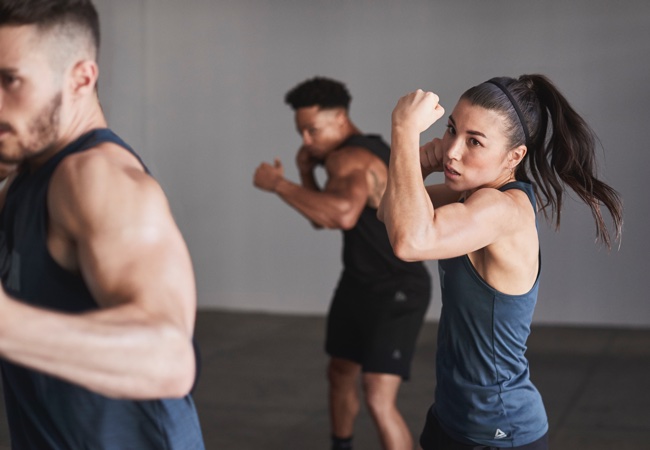
What makes for the ideal health club member? Someone who attends regularly, stays with you for years, and often recommends your facility to friends?
If this is the kind of clientele you’re after, it might be time to help more of your current members get sweaty in your studio through group workouts.
Members who attend group fitness classes visit their facility 4 times per week (compared to IHRSA’s industry average figure of 1.9 member visits per week). Meanwhile, those who do 3+ Les Mills classes per week stay members of their club 50% longer than those who don’t do classes – that’s an extra 9.8 months of dues per member. Furthermore, group fitness attendees recommend their gym to 18% more people than gym-only members, while 10% of group fitness attendees recommend to 10+ non-members.
Put simply, group fitness members are among the most valuable type of customer you can have. By staying longer and pulling in more new members, group fitness members form the bedrock of a successful club’s bottom line. So how do you identify these people and what can you do to add more of them to your club’s membership?
Who’s doing group fitness?
The answers can be found in the 2019 Les Mills Global Consumer Fitness Survey – the largest ever of its kind – which asked more than 12,000 people in 22 countries about their workout habits.
One of the standout findings was that Millennials and Gen Z are already the overwhelming majority in the group fitness market, representing 81% of all participants doing fitness class activities (such as yoga/pilates, dance, group workouts to music and small group training).

As well as highlighting Millennials and Gen Z as a key battleground for clubs, the report offers further insight into the make-up of the modern group fitness market. It shows that among people who regularly exercise, either at a fitness facility or at home:
- 46% are doing fitness class activities
- 59% of gym members do fitness class activities.
- 53% of casual members do fitness class activities.
- 56% of females do fitness class activities.
Given that fitness classes only really got going in the 1980s and for a long time were perceived as a niche element of the health club, the fact that 46% of today’s fitness market now does some form of class activity highlights the extent of the group fitness boom in recent decades. Meanwhile, the recent rise of boutique studios – which in 2017 held the greatest share of fitness memberships in the US for the first time ever (2018 IHRSA Health Club Consumer Report) – suggests this growth is set to continue.
So how can clubs encourage the group fitness behaviours that result in major retention benefits?
According to Ish Cheyne – Head of Fitness at the 12-strong Les Mills New Zealand (LMNZ) chain of clubs, where group fitness accounts for 50 per cent of overall gym attendances – helping new members build social connections at the start of their membership is the key.
“Nobody ever left a gym because they had too many friends,” says Ish. “So whether it’s allowing new members to bring a friend for free for a week, encouraging people to join as a group, or steering new members towards the ready-made community of the group exercise studio, do everything you can to help members develop friendships within the club.”
“This not only makes the experience more fun – and therefore something they’re more likely to repeat – but it also creates multiple points of contact for them in the club, meaning they’ll be missed if they don’t attend.”
WHAT’S DRIVING GROUP FITNESS ATTENDANCES?
So we know that more people are doing group fitness than ever before, with Millennials and Gen Z leading the charge, but what’s motivating members to seek strength in numbers over more solitary ways to sweat?
One thing that’s clear: group fitness members are fiercely committed to their mode of training. Aside from their longer average membership tenure, 57% of group fitness users say they’re likely to cancel their membership or stop attending their gym if their preferred class is cancelled.
On the flip side, maintaining a consistent timetable can pay dividends, with longstanding members naming group fitness as one of the key factors keeping them at their club. While 36% of new club members (tenure = < 6 months) cite group fitness as a primary reason for attending their club, this figure rises to 51% among members who have been at their club 3+ years.
INSTRUCTORS ARE ESSENTIAL
One of the most significant factors pulling people into group fitness classes remains the quality of the Instructor. Given the heightened value Millennials and Gen Z place on the social experience when choosing where to train, the ability of your frontline staff to inspire and motivate are a major dealbreaker.

The quality of the Instructor is the biggest single influence on where Millennials and Gen Z choose to do group workouts, with 37% listing this as their top reason for attending a class.
But they don’t just want flash. Substance over style is their preference for Instructors – with the most important quality (listed by 40% of respondents) being someone who coaches intelligently. This is even more significant for indoor cycle classes, with 79% of riders deeming the quality of the Instructor ‘extremely important’ when deciding which class to attend, and crucial to their overall enjoyment of a cycle class.
For Michael Steenhouwer, co-owner of a small chain of clubs near Stockholm in Sweden, focusing on raising the quality of group fitness Instructors has been integral to his success, with a staggering 68% of all club visits now attributable to group fitness.
“At our gyms, our top priority has always been to deliver high-quality group fitness and to be the absolute first choice in our area,” says Michael, who is also a Les Mills Trainer and Presenter.
“Having great Instructors at our clubs has inspired many members to themselves become Instructors, which in turn helps the growth of our business. I really believe in the philosophy of ‘surround yourself with good people” and ‘study the greats and become greater’.
“My sister and I mentor the next generation of Instructors ourselves, and the high value we place on group fitness – plus how seriously we take our responsibilities as Instructors – informs their attitude and development.”
HOW ARE PEOPLE PARTICIPATING IN GROUP FITNESS?
While rockstar Instructors are more important than ever for driving footfall through a fitness facility and keeping members engaged, advances in technology are opening up new ways for people to enjoy group fitness beyond the traditional live class setting.
The 2019 Les Mills Global Consumer Fitness Survey reveals that today’s fitness consumer – particularly Millennials and Gen Z – demand a seamless, connected fitness experience which suits their lifestyle and enables them to work-out on their terms.

The numbers show that Millennials and Gen Z account for over 65% of virtual fitness participants in clubs. Meanwhile, 85% of all gym members also now do workouts at home, illustrating the importance of catering for all types of fitness experiences if your club is to inspire loyalty among modern members.
From a group workout perspective, this means a fully-integrated live, virtual, and at-home solution that can truly take your club’s reach beyond the four walls and into every aspect of a member’s fitness journey.
“Without a doubt, technology is going to power the next great growth in fitness – ‘Fitness 2.0’ if you like,” says fitness and technology expert David Minton.
“The interplay between the club and on-demand fitness will no doubt increase, and this will mix very well for clubs which can provide high-quality content and 360-degree fitness offerings for their members.
“Those who fail to adapt could find their members turning to influencers and fitness streaming services, so operators have to stay very aware of consumer preferences and what’s coming.”
WHAT ARE THEY DOING?
The Fitness Survey unearthed several key insights on the types of group workouts consumers are leaning towards.
Among the 46% of today’s fitness market who regularly do some form of class activity, the majority (60%) prefer working out in large groups, versus the smaller groups of 6-8 people you might find in small group training type sessions.
Les Mills workouts continue to account for a significant chunk of group workouts to music globally, with 45% of these participants saying they regularly do Les Mills group workouts. 86% of this group are ‘extremely satisfied’ or ‘satisfied’ with the classes they attend.
In terms of genre, there’s a fairly even split between the types of group workouts people are doing at a global level, despite regional preferences. With fitness becoming more diffuse as a greater number of options help bring more people into the fitness market, yoga/pilates, dance, group workouts to music, indoor workouts, functional group workouts and small group training are all tracking within a couple of percentage points of each other when it comes to market share.

What the research did show was that martial arts-themed classes are great for boosting member loyalty – more effective than any other class type. 87% of members who do martial arts-focused group workouts attend their gym 3+ times per week – way above the IHRSA industry average of 1.9 visits per week.
This is particularly true at Holmer Park Spa and Health Club in the UK, where star Instructor Hazel Davies’ BODYCOMBAT™ classes are consistently the most popular on the timetable, translating into big wins for her club’s bottom line, and life-changing experiences for her participants.
“I wasn’t surprised at all to hear that you wanted to profile Hazel,“ says Assistant Manager Dan Phillips. “Her attendances for BODYCOMBAT this week alone are 100 per cent capacity, with a further five people on the waiting list. Hazel’s next classes are typically fully booked straight after her class has just finished and in future, we will look to build another studio to keep up with demand.
“We currently have over 60 classes here at Holmer Park and BODYCOMBAT is the best performing class annually – which is a real credit to Hazel. Her next classes are typically fully-booked straight after her class has just finished, and in future, we will look to build another studio to keep up with demand.
Dan adds: “From a club point of view, we had 112 new joiners in September alone, resulting in our highest direct debit of memberships in the club’s history. I know this has a huge amount to do with our instructors and classes as evidenced by the feedback we have from our suggestion box at reception.
“The returns on full classes speak from themselves – we have 60 classes a week all full, which means we are clearly doing something right. Each member is precious to us, so if you put that as your highest priority, with each member paying nearly £70 a month, that’s a huge revenue driver for us.”
GENERATION ACTIVE ARE CHANGING THE GAME – AND THEY NOW MAKE UP 80% OF GYM USERS
Learn the new rules of fitness and how your club can win with the 2019 GLOBAL CONSUMER FITNESS SURVEY.
DOWNLOAD THE FINDINGS